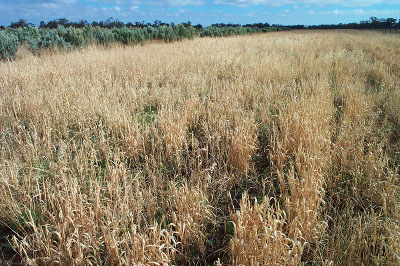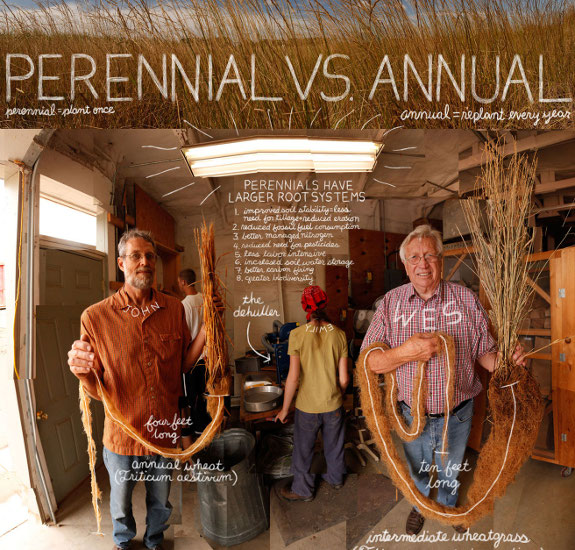
Grain-based livestock farming
 Two of the three chapters we
read this week in Folks,
This Ain't Normal
focused on our modern, grain-based, livestock-farming system, so I
thought that would be a good topic for this week's discussion.
Salatin explained that before modern machinery made harvesting and
processing grain a breeze, wheat, rye, barley, and oats required too
much labor to be fed to livestock. This was a good thing because,
in areas where grain production wasn't used sparingly, deserts soon
began to encroach on farmland.
Two of the three chapters we
read this week in Folks,
This Ain't Normal
focused on our modern, grain-based, livestock-farming system, so I
thought that would be a good topic for this week's discussion.
Salatin explained that before modern machinery made harvesting and
processing grain a breeze, wheat, rye, barley, and oats required too
much labor to be fed to livestock. This was a good thing because,
in areas where grain production wasn't used sparingly, deserts soon
began to encroach on farmland.
Then tractors and
combines came along, providing cheap tillage and processing, while
chemical fertilizers allowed us to grow massive amounts of grains
without closing the ecosystem loop with enough animals to feed the
soil. Add in cheap fuel to transport those now-copious grains,
and we saw another sea shift in agriculture --- meat and dairy animals
were crammed into CAFOs where they were fed grains and where their
concentrated manure became a waste product instead of a sought-after
source of fertility. Animal cruelty and meat quality aside, the
system is clearly broken from a purely biological perspective.
 Salatin asserts that there is
a better way. Herbivorous meat animals (cows, sheep, and goats)
can be raised entirely on pasture, which when managed correctly can
heal soil that is otherwise valueless for agriculture. If we kept
our animals on pasture, we'd only have to grow grains for people, and
there are a couple of very sustainable approaches to grain production
to choose between. Colin Seis, an Australian experimental
farmer, has developed a system of growing grains without tilling within
a traditional pasture, with each plot of land producing grains one year
in five. Meanwhile, Wes Jackson is developing perennial
grains that only require the ground to be tilled and planted once or
twice a decade.
Salatin asserts that there is
a better way. Herbivorous meat animals (cows, sheep, and goats)
can be raised entirely on pasture, which when managed correctly can
heal soil that is otherwise valueless for agriculture. If we kept
our animals on pasture, we'd only have to grow grains for people, and
there are a couple of very sustainable approaches to grain production
to choose between. Colin Seis, an Australian experimental
farmer, has developed a system of growing grains without tilling within
a traditional pasture, with each plot of land producing grains one year
in five. Meanwhile, Wes Jackson is developing perennial
grains that only require the ground to be tilled and planted once or
twice a decade.
Although Salatin doesn't
mention this, the obvious question is --- can these systems be tweaked
so the food is affordable for folks who aren't wealthy? My answer
to this biological-farming question (which is also raised about
permaculture and organic gardening) is: "Who cares how much ethical
food costs? Grow your own and it's cheaper than the mainstream
stuff in the grocery store, which really costs a lot more than you
think if you add in the environmental side effects." But it is
true that cows are a lot harder to fit into a backyard than
zucchinis. What do you think?
We're skipping next week (since I'll be regaling you with a lunchtime series about trailer dwellers), then we'll discuss chapters
17 through 19 on January 2. If you're just tuning in, you might
want to check out part
1, part 2, and part
3 of the book club
discussion. Thanks for reading along!
Want more in-depth information? Browse through our books.
Or explore more posts by date or by subject.
About us: Anna Hess and Mark Hamilton spent over a decade living self-sufficiently in the mountains of Virginia before moving north to start over from scratch in the foothills of Ohio. They've experimented with permaculture, no-till gardening, trailersteading, home-based microbusinesses and much more, writing about their adventures in both blogs and books.
Want to be notified when new comments are posted on this page? Click on the RSS button after you add a comment to subscribe to the comment feed, or simply check the box beside "email replies to me" while writing your comment.

A fair portion of the world's population lives in crowded apartment buildings. They, also, need to be fed.
I do believe that it's possible to feed the world's population with sustainable agriculture, including pastured rather than grain-fed meat, but growing your own is not an option for the majority of people.
But: feeding grain to cows produces more beef per acre than feeding grass only, ie- more acres could be left truly natural. Secondly, "natural grassland" would include bovines anyways, an important part of the ecosystem. Without the buffalo eating the young sapplings as they sprouted, the Great Plaines would have succeeded into scrub bushland, then forest. Modern ag has given us single species grassland and keeps the bovines penned up, but the algorithm is basically the same, with higher productivity.
Again, the pro food producer has to rely on hi volume production & sales to remain profitable. Why do it if you only break even? He sells his cattle at $1.50/lb. Spending $200/hd on grain and a couple bucks on antibiotics & estrogen, he'll get an extra $150/hd. That may be the only profit he would see.
As Sarra mentions, not everybody is able to grow their own food.
And looking at the data it seems extremely unlikely that it is feasable to feed even the current world population without modern energy intensive agriculture.
Looking at a relatively modern four crop rotation system (wheat, turnips, barley and clover), yields of edible plants would be three years out of four. So at least 25% lower than using nitrogen fertilizer and other additives each year.
Food security for the future might also necessitate draconian population control. It is estimated that the US would have to reduce its population to 200 million to be able to feed itself with sustainable architecture (I would have linked to report, but I seem to have misplaced the link). The current projection for 2050 is around 430 million...
I would agree completely that the current system of grain-based livestock frming should be abolished. Not only is it inhumane, it is also highly inefficient and harmful in other areas (like overuse of antibiotics)
good discussion.
if you want to live in a city and not help making your own food you better be good at convincing those who are working to help you!
Or you could give up and start working ( helping farmers ) and trading your work for food from farmers like Anna.
Is our government really of the people, by the people and for the people or of the government, by the government and for the government?
Food for thought? I prefer the food I can eat that I have grown.
Now what about taxes?
Do we really need help deciding what to do with the food and other items of value we create?
You get the idea?
Just my opinion of course :).
We could abolish feed lots/grain feeding here in the US if consummers were willing to pay an extra buck or two per lb of meat. As I said, that extra 100 lb per head is the difference between profit & break-even for the producer...BTW- using antibiotics in cattle adds ~50 lb per head. It doesn't really prevent disease, but alters the gut flora to make the feed/ wt gain more efficient. .."Antibiotic resistance" is a point argued only by the naive: food-borne enteral disease is essentially not treated with antibioics, so resistance in the causative bug is not germaine to the care rendered.
As long as we're talking about beef & nutrition: to get 60 gm complete protein from a diet of rice, beans & corn, you'd have to take in about 3500 cal, enough to make almost anybody obese. That same 60 gm would be provided by only 500 cal of beef and it gives you more vits & minerals too.. Your mother was right: eat a little bit of everything.